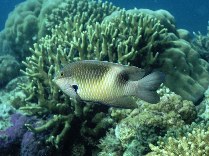| Family: |
Pomacentridae (Damselfishes), subfamily: Pomacentrinae |
| Max. size: |
18.5 cm TL (male/unsexed) |
| Environment: |
reef-associated; brackish; marine; depth range 1 - 12 m, non-migratory |
| Distribution: |
Indo-West Pacific: Nicobar Islands to Vanuatu, north to the Ryukyu Islands, south to northwest Australia and the Great Barrier Reef (Ref. 9710). |
| Diagnosis: |
Dorsal spines (total): 13-13; Dorsal soft rays (total): 14-16; Anal spines: 2-2; Anal soft rays: 14-15. Description: The true D. prosopotaenia is white-breasted and lacks the large black blotch on upper sides; the yellow-breasted variation with black blotch (Ref. 48636). Juvenile head and body white, vertical bars brown broad, spot large round black with margin yellow. Body depth 2.1-2.3 in SL (Ref. 90102). |
| Biology: |
Adults inhabit lagoons and coastal reefs, usually in silty areas (Ref. 4966). The true D. prosopotaenia ranges from Singapore to Sulawesi while the yellow-breasted variant ranges from Irian Jaya to eastern Australia and Vanuatu (Ref. 48636). May be found solitary or in groups (Ref. 90102). Oviparous, distinct pairing during breeding (Ref. 205). Eggs are demersal and adhere to the substrate (Ref. 205). Males guard and aerate the eggs (Ref. 205). Diurnal species (Ref. 113699). |
| IUCN Red List Status: |
Least Concern (LC); Date assessed: 23 September 2021 Ref. (130435)
|
| Threat to humans: |
harmless |
Source and more info: www.fishbase.org. For personal, classroom, and other internal use only. Not for publication.
